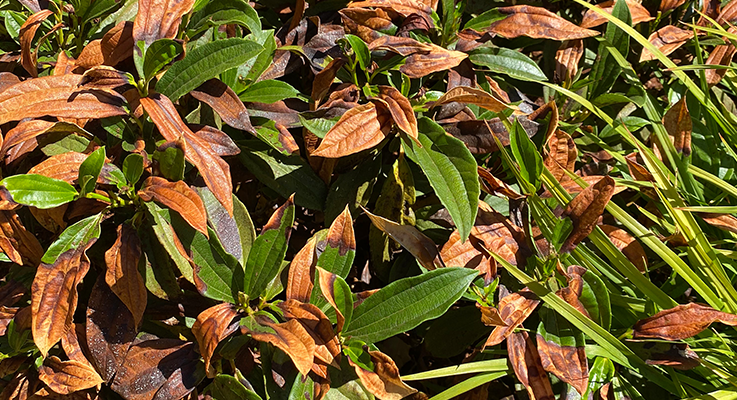Previously, I have discussed some of the effects of the very dry summer season, not only in the Pacific Northwest, but in much of the western United States. Many readers and other gardeners commented about the article.
Looking around my neighborhood in the Portland area in early September, I could see many mature trees that appeared stressed by the conditions of climate change. Gardeners were stressed, too. They were near unanimous in saying, “We need rain.”
Adjusting to conditions
In most home garden conditions, the gardener can usually provide adequate moisture for small trees and shrubs, but providing water for large trees is usually not an easy task. Recently while having dinner in an outdoor space at a local restaurant, I noticed that the surrounding trees appeared to need a thorough soaking with water. I asked the owner if he was watering them. He replied, “Yes, as best as I can.”
It was clear what he meant, because more than 90% of the root zone was under hardscape. The trees were initially planted with the expectation that there would be adequate ground water, but now that is not the case.
Since we don’t control when or if rain falls, we need to adjust to the conditions that we experience. When visiting garden centers and seeing the fall bulbs arriving, I wonder if it connotes a signal of optimism for spring or just a sign that perhaps we have not changed our thinking about climate change.
Both gardeners and garden centers must adapt to what might become new gardening practices. These new practices are much more involved than just learning about new plants that can tolerate dry conditions. They also include learning more about the soil, fertilization, soil amendments, sun and shade requirements, and meeting the gardener’s desires. There is no precedent to build upon, but all these factors might need to be re-adjusted considering the current climate situation.
One of the comments that I received from a reader was from Barrie Coate, who lives in Fairfield, California, in the north bay sub-region of the San Francisco Bay area. Barrie is a well-known certified arborist as well as a horticultural consultant. He has previously witnessed many of the environmental changes in his region that we are now seeing in the Pacific Northwest.
“Unfortunately, homeowners and many landscape architects refuse to change their plant decisions because the landscapes around them are composed of species they are familiar and comfortable with,” Barrie wrote. “It may require may years for us as plantsmen to adjust and help owners and landscape architects to accept plants they are not familiar with for the sake of more climate-tolerant landscapes.”
The top of the zone
Most garden books, plant catalogs, internet plant descriptions and general plant usage information will mention a low temperature zone. That is what is considered the low temperature that a particular plant can withstand without damage.
“One factor which is commonly understood is low temperature tolerance, but less mentioned is high temperature tolerance.” Barrie continued. “Factors which are seldom mentioned, but which are critical to plant success, include soil chemistry, irrigation water chemistry, topsoil depth and percolation rate, and sub soil texture and percolation rate. The excitement over the use of native plants, as important as the subject is, neglects to emphasize, in most literature, how important soil texture and soil percolation rates are to plants.”
Using the term “native plants” often conjures up a feel-good moment with the gardener, because the idea that a plant is native somehow makes it more acceptable. Many native plants fulfill a much-neglected niche by providing a food source for many pollinating native bees, butterflies, and other beneficial insects.
Certainly with commercial development, the loss of native habitat is staggering. If we can replenish even a small portion of the native habitat, it is a benefit for the planet. Just because a plant is a native does not mean that it will easily fit into many modern garden settings. However, gardens are constantly changing and slowly adding certain native plants can be a positive step in helping some of our native insect populations.
Soil chemistry is often an overlooked factor in planting. The standardized response to most questions regarding soil – “just add compost and fertilizer” – is not always the best response.
Does compost really need to be added to the soil of a plant that prefers a porous and fast draining environment? Is adding phosphorus when planting a new shrub or tree to “encourage root development” necessary if the soil already has a high phosphorus content? These are just two common questions that need to be addressed.
An educational mission
It is safe to say that in the horticultural industry, we are treading into areas that have probably not been thought much about. The zone for low temperature tolerance is usually noted by gardeners, but few have considered high temperature tolerance, or all of the specific chemical compositions of their soil.
Thus, it seems that garden centers have a great new educational mission in teaching their customers about the horticultural effects of the current climate changes. It is vital that we all keep abreast of new information and process it. Universities with horticulture departments and extension services are often excellent resources for new gardening information.
In this unprecedented time, we all need to work diligently, keep an open mind and be willing to accept and adapt new scientific principles that can help our gardens and the trees and shrubs that are planted to perform at their optimal level. Much of the implementing the challenge of coping with climate change will fall to garden centers and their staff. It is important that they meet that challenge and continue to inspire hope in gardeners.

